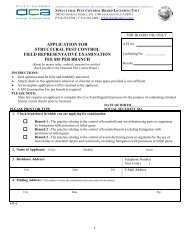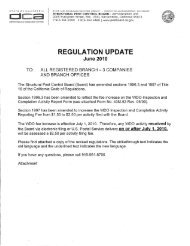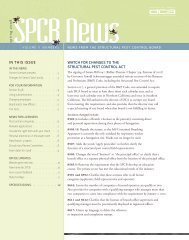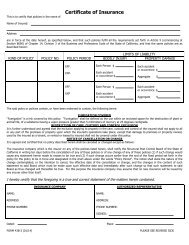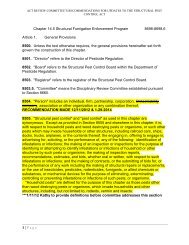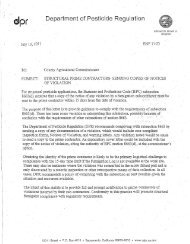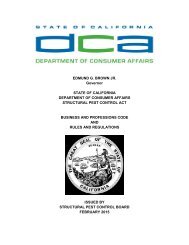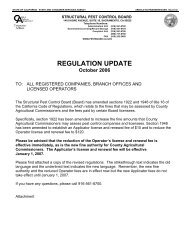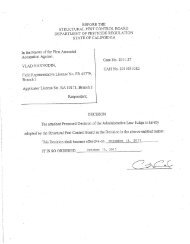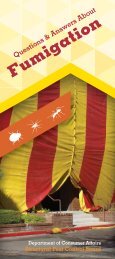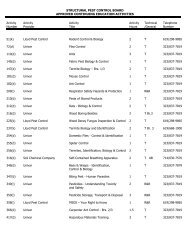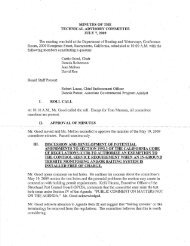August 2006 - Structural Pest Control Board - State of California
August 2006 - Structural Pest Control Board - State of California
August 2006 - Structural Pest Control Board - State of California
You also want an ePaper? Increase the reach of your titles
YUMPU automatically turns print PDFs into web optimized ePapers that Google loves.
or reinforced. <strong>Structural</strong> members which are structurally weakened by fungus to the<br />
point where they no longer serve their intended purpose shall be removed or, if<br />
feasible, may remain in place if another structural member is installed adjacent to it to<br />
perform the same function, if both members are dry (below 20% moisture content), and<br />
if the excessive moisture condition responsible for the fungus damage is corrected.<br />
<strong>Structural</strong> members which appear to have only surface fungus damage may be<br />
chemically treated and/or left as is if, in the opinion <strong>of</strong> the inspector, the structural<br />
member will continue to perform its originally intended function and if correcting the<br />
excessive moisture condition will stop the further expansion <strong>of</strong> the fungus.<br />
(6) Comply with the provisions <strong>of</strong> section 2516(c)(6) <strong>of</strong> Title 24 <strong>of</strong> the <strong>California</strong> Code<br />
<strong>of</strong> Regulations.<br />
(7) Comply with the provisions <strong>of</strong> section 2516(c)(4) <strong>of</strong> Title 24 <strong>of</strong> the <strong>California</strong> Code<br />
<strong>of</strong> Regulations.<br />
(8) Exterminate all reported wood-destroying pests. Such extermination shall not be<br />
considered repair under section 8516(b)(12) <strong>of</strong> the code. If evidence indicates that<br />
wood-destroying pests extend into an inaccessible area(s), recommendation shall be<br />
made to either:<br />
(A) enclose the structure for an all encompassing treatment utilizing materials listed in<br />
Section 8505.1 <strong>of</strong> the code, or<br />
(B) use another all encompassing method <strong>of</strong> treatment which exterminates the<br />
infestation <strong>of</strong> the structure, or<br />
(C) locally treat by any or all <strong>of</strong> the following:<br />
1. exposing the infested area(s) for local treatment,<br />
2. removing the infested wood,<br />
3. using another method <strong>of</strong> treatment which exterminates the infestation. (If any<br />
recommendation is made for local treatment, the report must contain the following<br />
statement: “Local treatment is not intended to be an entire structure treatment method.<br />
If infestations <strong>of</strong> wood-destroying pests extend or exist beyond the area(s) <strong>of</strong> local<br />
treatment, they may not be exterminated.”)<br />
When a complete inspection is performed, a recommendation shall be made to<br />
remove or cover all accessible pellets and frass <strong>of</strong> wood-destroying pests.<br />
When a limited inspection is performed, the inspection report shall state that the<br />
inspection is limited to the area(s) described and diagrammed. A recommendation shall<br />
be made to remove or cover all accessible pellets and frass <strong>of</strong> wood-destroying pests in<br />
the limited areas. The limited inspection report shall include a recommendation for<br />
further inspection <strong>of</strong> the entire structure and that all accessible evidence <strong>of</strong> wooddestroying<br />
pests be removed or covered.<br />
(9) For the extermination <strong>of</strong> subterranean termite infestations, treat an infested area<br />
under the structure when subterranean termite tubes are found connected to the ground<br />
or when active infestations are found in the ground. Subterranean termite tubes shall be<br />
removed where accessible, except where a licensee is using an above ground termite<br />
bait station that requires the use <strong>of</strong> the termite tubes to be effective. Where a licensee is<br />
using an above ground termite bait station that requires the use <strong>of</strong> termite tubes to be<br />
effective, subterranean termite tubes can remain in place for the duration <strong>of</strong> the<br />
licensee's use <strong>of</strong> the termite bait stations. At the conclusion <strong>of</strong> the treatment, the<br />
subterranean termite tubes shall be removed.



